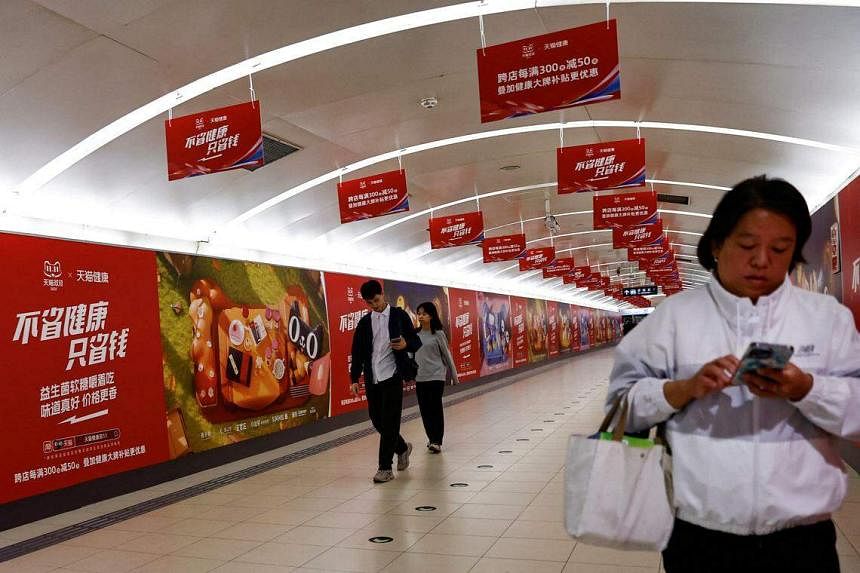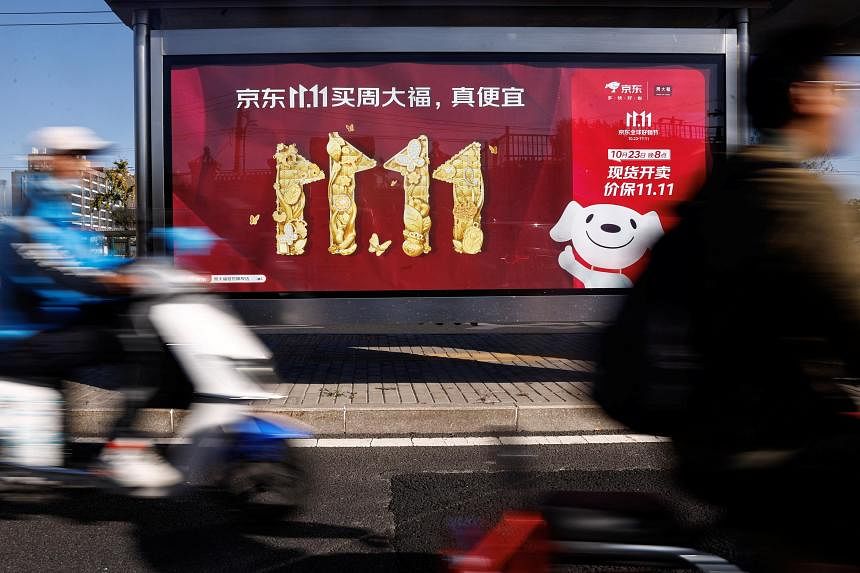Alibaba Group and JD.com reported sales increases during China’s most important shopping festival, yet likely lagged behind newer entrants from among social media platforms such as ByteDance’s Douyin in a muted year for consumer spending.
Analysts hunted for clues after China’s two e-commerce leaders again failed to disclose overall revenue numbers during Singles’ Day, the annual bargains extravaganza.
Originally a 24-hour online shopping event held on Nov 11 each year in China, the Singles’ Day festival – a nod to the digits in the date – has expanded into weeks of promotions across the country’s major e-commerce platforms and at bricks-and-mortar stores.
Historically used as a barometer for Chinese consumer sentiment, it has become much harder to parse since companies stopped providing precise figures during the Covid-19 pandemic era.
Alibaba and JD.com likely managed 1 per cent to 3 per cent growth in gross merchandise value over the three- to four-week period leading up to Nov 11, when merchants embarked on their discounting spree, Goldman Sachs estimated.
Smaller rival PDD Holdings, which targets lower-income and rural markets, racked up growth of 20 per cent, analyst Ronald Keung estimated.
PDD owns Chinese shopping platform Pinduoduo.
Data provider Syntun, meanwhile, estimated that cumulative gross merchandising volume (GMV) sales across major e-commerce platforms rose 2.08 per cent to 1.14 trillion yuan (S$216 billion), slower than the growth of 2.9 per cent in 2022.
Alibaba and JD.com report earnings this week in a closely watched signal of how domestic consumption has recovered.
“The slowing growth shows we need to roll out large-scale economic stimulus measures that are strong enough to lift market confidence and drive up the economy,” well-known economist Ren Zeping, who was formerly a researcher at the State Council’s Development Research Centre, wrote on Monday.
“Consumers are becoming more mature and rational as they go after high value for money. Their perception of brands is also changing, and domestic brands with high value for money are rising.”
Chinese consumption has flagged in the country’s post-pandemic reopening, dogged by economic turbulence ranging from a crumbling property market to rising youth unemployment.
Deflationary pressures worsened in October, spurring concerns over the country’s growth trajectory.
Singles’ Day in 2023 focused on a low-price strategy to draw in reluctant consumers.
Alibaba’s Taobao and Tmall said their direct-discount venue offering 15 per cent price reductions notched 210 million orders, while as at midnight on Saturday over 400 brands in 2023 had exceeded 100 million yuan each in GMV.
JD.com’s credit payment business Baitiao brought together 400,000 brands and merchants to provide more than 1.5 billion yuan in subsidies for users.
The company said more than 60 brands surpassed one billion yuan in sales each, and that almost 20,000 brands reported that transaction volumes trebled from a year earlier.
“Growth during stage 1 (October 2023) was disappointing. Momentum likely picked up in November,” Jefferies analyst Thomas Chong wrote. “Having said that, growth momentum on the day of Nov 11 was slower than expected.”
“With cautious/selective spending behaviour and availability of alternative platforms, we believe consumers have plenty of choices for ‘value-for-money’ products,” Citigroup analyst Alicia Yap wrote. “Consumer shopping time and wallet share have been diluted and split among traditional marketplaces and short-video platforms.”

China’s postal delivery companies handled 639 million packages nationwide on Nov 11, an increase of 16 per cent from 2022, the State Post Bureau said on Sunday.
The number handled in the first 11 days of November totalled 5.3 billion, jumping 23 per cent, according to the bureau.
Less traditional platforms like Douyin and Kuaishou Technology likely thrived, drawing shoppers with more novel formats and a longer-than-normal discount period that began in mid-October.
The prolonged coverage plays in their favour because users spend more time on short-video platforms in general, Goldman’s Mr Keung said.
A recent Bain and Company report found that 77 per cent of the 3,000 consumers it surveyed had planned to spend less or the same amount on Singles’ Day compared with 2022.
Bain said shoppers intended to spend on necessities such as tissue paper, handwash, instant noodles and pet food, while trading down and buying less in discretionary or big-ticket categories such as home appliances and furniture.
Several consultancies predicted Singles’ Day GMV growth across platforms could return to double-digit growth for the first time since the pandemic, but the final sales picture will take time to emerge.
The GMV figures take into account the value of all orders placed, and do not capture the amount that will be returned later.
Analysts and industry executives expect return rates to be high in 2023, as consumers buy more in order to obtain larger discounts at checkout, only to return the items that they do not need.
BLOOMBERG, REUTERS

